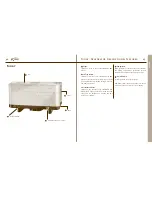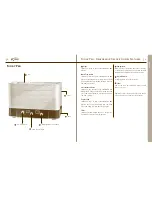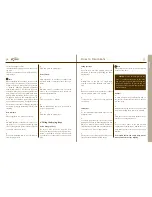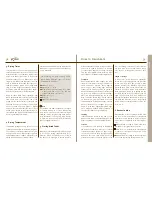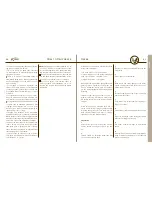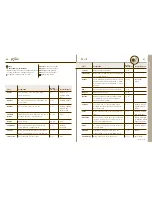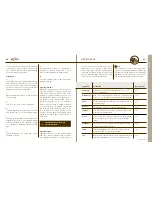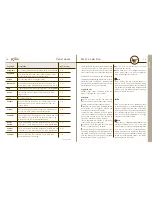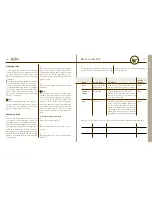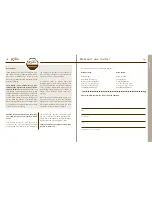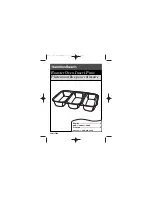
64
65
Dried fruit has no preservatives, is nutritious,
and has a naturally sweet taste. Suggested
uses: snacks, cookies, pies, cobblers, cakes,
breads, ice creams, pancakes, jams, fruit
leather, sweetener for waffles or cereals and
more.
Process
1
Select firm, ripe fruit (not overly ripe), free of
bruises and blemishes. Sort through grapes
and berries. Remove those with imperfections.
2
Wash fruit that is to be dehydrated with the skin.
3
Peel fruits, if desired or necessary. For easy
peeling of fruits such as peaches, dip in boiling
water until skin cracks.
4
Waxy skinned fruits like cherries, cranberries,
grapes (raisins), and blueberries that will be
left whole must have their skins poked or be
placed in boiling water for 1 – 2 minutes to re-
move waxy coating.
5
Berries may be blanched or steamed to pop
their skins which will shorten the dehydration
time. Cut, remove stems, stones, pits, cores
and seeds. Cutting uniform slices will allow
food to dry evenly.
6
Cut fruit into slices, pieces or halves. Uniform
1/2 cm slices are best for most.
7
See Page 55 (Pretreating) for fruits that may
turn dark during the drying process.
8
Use mesh inserts for any small fruits or pieces
that might fall through the holes in the dehy-
drator trays.
9
Place fruit evenly on trays. If using more than 4
trays rotate once during drying time.
Tutti-Fruit
Dissolve flavored gelatin according to directions
on package. Soak apple or pear slices in mix-
ture for 10 minutes. Blot dry on paper towels.
Dehydrate.
Variables can contribute to a large difference
in drying times. To test for dryness: remove a
piece of fruit. Let it cool. Cut or tear. Fruit should
have almost no moisture. Most fruits will still be
pliable and leathery. Bananas and strawberries
should be almost crisp. You can leave softer,
if you do not plan on storing for a long time.
Store dehydrated fruit in an airtight container.
Note
Dry fruit at 55 – 60 °C. Use average times only as
a general guidelineFruit Leather
Fruit
Fruit Leather
Pureed fruit dried in thin sheets becomes a
tasty, candy-like fruit leather snack.
1
Pit, then puree fruit of your choice, adding
just enough liquid (fruit juice or water) for the
blender to puree effectively. Often no liquid is
needed.
2
Fruit may also be mixed with applesauce. One
cup applesauce will prevent leather from crack-
ing or splitting.
3
If fruit is tart, you may also add a sweetener.
4
Lightly spray fruit leather sheets with vegetable
oil before pouring on puree to prevent sticking
when removing leather. You can also use a little
olive oil. Rub it on a fruit leather sheet with a
paper towel.
5
Place fruit leather sheet(s) into dehydra-
tor tray(s). Pour one cup of fruit puree onto
a sheet. Remember to leave the drying tray’s
center hole uncovered.
6
For adequate circulation, only one half of the
dehydrator drying tray should be used. Place
fruit leather sheets on alternate halves of the
trays in the stack.
7
After all fruit leather sheets are filled, stack the
drying trays on the base.
8
Set temperature to 60 °C. Dehydrate about 8 – 11
hours.
9
Rotate fruit leather sheets, (not dehydrator
trays), twice during drying time, (about every
3 hours).
10
Leather is done when you notice puree to
have a leather texture with no sticky spots.
It should easily remove from the fruit leather
sheet.
11
Wrap in plastic wrap and store at room temper-
ature or refrigerate.
12
Spices, chopped nuts or coconut may be add-
ed to the puree for extra flavor. For further
variation, puree several types of fruit togeth-
er. Don’t be afraid to experiment! Vary the
amounts according to availability, taste and
imagination. If the puree tastes good, the
leather will be better. Remember the flavors,
and sweetness, concentrate with drying.
ENGLISH




